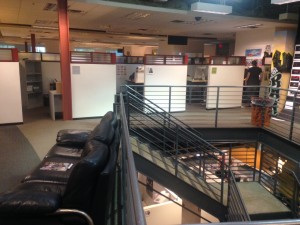Recently, Austin was named one of the top 10 best places for the LGBTQ+ community to live, just in time for Austin Pride this weekend. Ahead of the celebration, we chatted with members of the LGBTQ+ community and allies within the agency about what inclusivity means to them and how creativity can’t thrive without it. Keep reading to learn more about how an inclusive city and work environment makes all the difference.
Kirya Francis, VP of Diversity and Inclusion
How do you define inclusion?
I like to think of inclusion to be more like a salad. You come together as individuals and you get to stay an individual, but your presence will be missed if you are not there.
Why is it important for a company to participate in inclusive initiatives?
A company’s primary responsibility is to be profitable so that it can stay in business and employ talent. Inclusion makes people happier to be there, and happier people make a better product.
Kyle Nguyen, Media Planner/Campaign Manager
How have you experienced inclusion at GSD&M?
GSD&M’s culture is inherently inclusive with participation in community events like the Allies Diversity Summit and various panels where GSD&Mers share their stories.
How does an inclusive environment benefit the work that comes out of GSD&M?
It breaks down walls. The less time we worry about how others perceive us, the more time we have to focus that energy on actually working by bringing our authentic selves to work.
Josh Andrews, Assistant Account Manager
Why is it important for a company to participate in inclusive initiatives?
It’s important for employees to see reflections of themselves and their identities at work. Without a place to be yourself, employees risk losing themselves to the nature of putting up a guard to those around them.
How have you experienced inclusion in Austin and at GSD&M?
There are LGBTQIA sports teams, book clubs and even Zilker meet-ups. I’m very happy to see the solidarity of GSD&M walking in Austin’s Pride parade, so cheers to that!
Ashley Davidson, Digital Producer
How do you define inclusion?
Inclusion is providing an atmosphere of support and involvement for all people regardless of race, religion, background, abilities, gender or sexual orientation. An inclusive environment empowers, educates and collaborates so an individual’s worth is recognized by all.
Why is it important for a company to participate in inclusive initiatives?
Inclusivity initiatives that support all groups are important for morale, productivity, safety and community-building. You build a stronger company where people both tolerate and celebrate each other’s differences.
Ana Leen, Account Leadership
How have you experienced inclusion at GSD&M?
Through partnering with organizations like ADCOLOR, E4Youth, Time’s Up/Advertising, Austin Pride and more, we’re both impacting and learning from our community that feeds the pipeline of creativity.
How does an inclusive environment benefit the work that comes out of GSD&M?
We will think beyond the norm. We will come up with ideas and creative that connect with people in new ways. We will give brands the opportunity to do things differently and stand out from the competition.
Companies need to push inclusion initiatives throughout the year, not just during Pride month. While we’re lucky to live in a welcoming city like Austin, we should never take that for granted. We must continuously celebrate and advocate for inclusion to better our community, our industry and the society in which we live. It’s a disservice to creativity and culture at large if we are not including and representing all voices and speaking up for those who aren’t heard.
Another year has come and gone, so it felt like the right time to reflect on all of the goodness that came out of GSD&M. 2018 was filled with game-changing work, much-needed conversations, well-deserved celebrations and, of course, so much good music. I somehow managed to narrow down what I believe to be GSD&M’s finest moments to 11 highlights and one playlist. Keep reading for a glimpse into last year.
Harry’s: A Man Like You
Breaking stereotypes and creating a cultural conversation around media’s portrayal of masculinity, the Harry’s short film was a breakthrough way of storytelling for a men’s grooming brand. The work even earned a Cannes Lions for film and a Glass Lion for change.
GSD&M Party at SXSW 2018
We gathered thousands of our closest friends, community members and partners in our backyard for the 8th Annual GSD&M Party featuring White Reaper, Durand Jones & The Indications, Pale Waves and Lukas Nelson & Promise of the Real, and we’re ready to do it again!
Time’s Up/Advertising
Alongside 200 female leaders in advertising, GSD&M’s President, Marianne Malina, was a founding member of Time’s Up/Advertising™. GSD&M helped lead the movement of saying “time’s up” on inequality in our industry and fronted a launch event across 14 cities in North America and Canada.


Winning Jack Link’s + Retaining U.S. Air Force
We took a break from our desks and gathered in the backyard to celebrate all of the hard work that led to winning our new client, Jack Link’s, and retaining our 17-year client, U.S. Air Force, for another 10 great years.

ITMAD 2018
From futurists to improv teachers and leading chocolate connoisseurs, GSD&M brought in the brightest minds inside and outside of Austin to inspire and discuss what it means to create ideas that make a difference.
Winning Pizza Hut
We welcomed our newest client, Pizza Hut, with champagne, and of course, PIZZA!

GSD&M Presents: Jared & The Mill
Arizona folk rockers, Jared & The Mill, stopped by while on tour to play some acoustic versions of their latest jams.
Free the Bid
In order to continue the mission of creating more diverse and meaningful work, GSD&M pledged to Free the Bid and put more women editors and directors on projects.

Halloween at GSD&M
As an office of creatives, we don’t take Halloween lightly. From The Shining Twins to Guy Fieri, this year’s costume contest was far from overrated.


Popeyes Emotional Support Chicken
The TSA-friendly, emotional support animal you can eat, Popeyes’ Emotional Support Chicken, took the media by storm. Appearing in Cosmopolitan, Delish.com, USA Today and much more, everyone ate it up, quite literally.
GSD&M Holiday Card: Austin Pets Alive!
This year, we used our annual holiday card to give back to our local animal shelter, Austin Pets Alive! Including an 18-foot “wishlist tree”, donations from employees, a GSDM.com takeover, and a card sent to our favorite family, friends and clients, our holiday initiative raised tons of awareness, funds, and shelter necessities, and gave every animal a blanket to keep warm this winter.
And to top it all off, here’s a comprehensive playlist featuring every song from GSD&M’s monthly playlists in 2018.
If last year is any indication of how 2019 will go, I’d say we have a lot to look forward to.
Dedicating 40+ hours a week to one office, one specialty, one computer, can be especially draining when we get sucked into the routine. That’s where a side hustle comes in—an outlet to create outside of the workplace and make some money while doing it. This year, over 44 million Americans reported having some sort of side hustle.
GSD&M employs a whole slew of crazy-talented folks, so you bet there are some side hustles around here. I dug a little deeper into the double lives of ad gurus by day and hustlers by night to see what passions they’re turning into profit.
Chelsey Korman, founder of Peach Electric: a real rad vintage shop for rad, real women
What took your side hustle beyond a hobby?
I’ve loved the art of fashion and the beauty of a thought-out outfit my entire life, and have wanted to explore it as a business for as long as I can remember. One day, I just figured I’d better start somewhere. This is just the beginning, I feel.
How has your side hustle made a difference in your day job?
It makes me appreciate all the departments in GSD&M. Reaching 100 Instagram followers was a huge achievement and honestly, some were sympathy followers. Ha. But seriously, social media experts are seriously smart and creative, and they understand what it means to “reach and connect” with an audience. We all have so much to learn from each other.

Laura Guardalabene, Cofounder of JUNK-O: creators of enamel pins inspired by pop culture and progressive political ideology
Where do you find inspiration to keep up the side hustle?
I follow a lot of other pin makers and small independent clothing brands. Companies like Lazy Oaf and Big Bud Press show me the growth potential JUNK-O has and how far hustling can get you.
How has your side hustle made a difference in your day job?
It has fueled my creativity tenfold. I no longer experience creative blocks or burnouts because I’m constantly challenging my mind and keeping it in shape.

Julia Elizondo, Cofounder of LA LO LA: a luxe resortwear line offering small batch collections
Where do you find inspiration to keep up the side hustle?
Through everyday things like a new issue of W Magazine or Condé Nast Traveler or just the simple dream of wanting to see women in our clothes. I want the chance to keep evolving the styles and collections into what I really want.
What does this work outside of the office mean to you?
It means that I can pursue my dream while still being able to make a living working in a dynamic place like GSD&M. It’s an outlet for me too.

Jeffrey Butterworth, founder of ArterBarter: a website to auction off original art pieces one by one, for anything BUT cash
What took your side hustle beyond a hobby?
Bringing a concept to satisfy the question I have been asking myself, “What am I going to do with my art?”
How has your side hustle made a difference in your day job?
A big part of what I do at work is trying to put together things that people would be interested in and attach it to a brand that makes sense. This is no different, it’s just that I’m the brand I’m attaching the idea to.
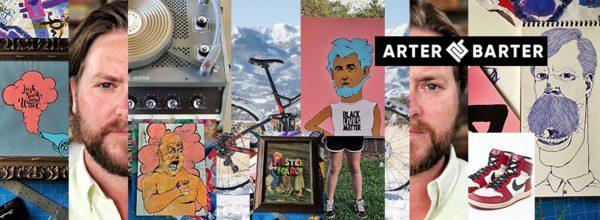
Turning a passion into profit is hard, rewarding, meaningful work. Judging from the side hustlers above, work outside of the office creates a source of energy, drive and satisfaction that might otherwise go unused. Everyone needs an outlet, so might as well make some extra cash while you’re at it. Keeping your brain “in shape” isn’t a bad way to get your exercise, either. If you’ve got something in mind, why not give it a go and see what happens?
How often in this industry can we say we’re truly changing lives? How often are we given an opportunity to sell hope instead of product? Those briefs are few and far between. So when Walgreens asked us to create a campaign for their HIV-specialized pharmacies that could help build a better future for those affected by the disease, I was both humbled and elated.
Going into this project, I didn’t know much about HIV. I knew there had been advances in treatment and that people were living longer. But I didn’t know that doctors now consider HIV a chronic disease, not unlike diabetes or high blood pressure. If you’re diagnosed early and adhere to your treatment regimen, you can live a long, healthy life. That was news to me. And as we learned during our briefing, it was still news to the rest of world.
Stigma and fear are the biggest deterrents to getting tested and beginning treatment.
A few days after the briefing, I was sitting in my partner’s office kicking around ideas when he threw out, “Let’s Grow Old Together.” We saw the genius in it immediately. What better way to tell people that their diagnosis is not a death sentence than with the promise of old age. While the line was great, saying you were going to live a long time wasn’t enough. We needed to show people that they could actually grow old with HIV. And that’s when the idea of a virtual timeline came into existence—starting with diagnosis and going through every milestone of the HIV journey, all the way to retirement.
And what if we had people living with HIV be our guides along that timeline, sharing their stories, advice and inspiration at each milestone?
It was a big, ambitious idea—much bigger than the print ads, banners and trade show booths the client was expecting. It was also a digital-first idea, requiring a highly emotive and immersive site experience to truly do it justice. One of the first challenges we faced was integrating that experience into Walgreens.com, a primarily e-commerce destination. Finding the appropriate solution wasn’t easy. We worked tirelessly with Walgreens web team and our dev partner MediaMonks, ultimately landing on an elegant solution (plus I learned what canonical tags are).
With the technical part mostly ironed out, it was time to produce the content for the site. Two rounds of casting led us to seven amazing people leading full, happy lives in spite of their diagnosis.

Like a man who’d been diagnosed in the ’80s, an HIV-positive and HIV-negative married couple and a woman who’d only had two T cells at the time of her diagnosis. Walgreens also introduced us to an HIV pharmacist who has an incredible relationship with his patients—a you-couldn’t-script-something-this-sincere-and-heartwarming relationship.
The shoot was filled with tears, revelations and, most importantly, hope.

On the last day, one of the women we were interviewing revealed she’d never really believed she had a bright future until this shoot. Hearing the stories of others just like her had given her a new perspective. If creating the site was this meaningful for the HIV patients we were filming, imagine how transformative it could be for the rest of the HIV community.
Nearly a year from concept to creation, the site is now live, and we’re beginning to hear positive responses from the HIV community. I’ll be the first to admit I didn’t go into advertising to change lives. But now I can say it’s the reason I’ll stay in it.
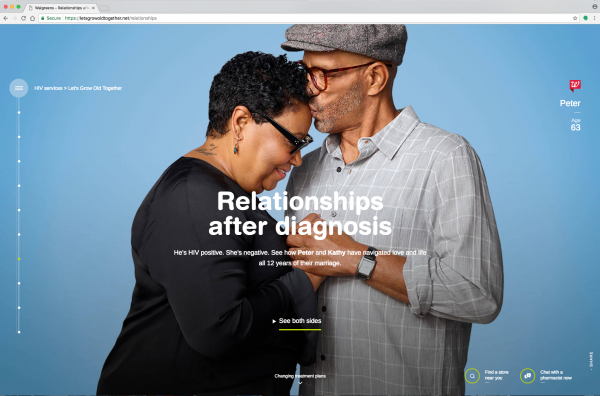
Visit and experience “Let’s Grow Old Together” here.
I spent two days at the Transition Percolate marketing conference in New York City, and one of the most insightful panels was titled, How to Build an Inspired Customer Community. Nikki Rappaport, director of brand and marketing at Cava Grill, has helped grow a local restaurant into a national chain with an engaged social community. Her tactics may be easier to execute within a small organization, but that’s no excuse. Here’s what we learned:
Be nimble. When Nikki started at Cava Grill, the social photography was less than stellar. She went beyond styling better food photos and actually changed the way the restaurants were presenting food. By making a few small tweaks in how the kitchen added garnish and sauces, she was able to inspire the brand’s advocates to post more pictures on social.
Follow-through is key. Cava Grill keeps track of each user asking for new restaurant locations, then follows up with them on social when they launch in the requested city. They’ve done the same with specific product requests—tagging vegetarians in social posts announcing new meat-free menu items.
These are just a few of the simple concepts presented at Transition Percolate that have a huge impact, which big brands should be executing. Changing an organization’s process is not an easy task, but if you’re nimble and you follow through, you can build an inspired customer community.
#Transition2016
It's time for the @WaPoExpress Best Of 2016 list! We hope you'll vote: https://t.co/KWqgs74ZWV #BestQuickLunch pic.twitter.com/UYsKnfCFrU
— Cava Grill (@CavaGrill) September 12, 2016
Aerie, American Eagle’s undies brand, has done away with advertising retouched models and is keeping it au naturel, and we (and its sales numbers) are in favor. As a group of strong-minded, creative female consumers in the advertising industry, we had some opinions about this business decision and its recent news, naturally.
Heather Apple, senior writer. Bold as she is blonde.
“Brands can support women for good and for profit. That’s what Aerie’s success proves: These aren’t mutually exclusive. It’s common sense. We spend so much time trying to understand our target; we should represent them—all of them.
“We still have a lot of strides to make to represent women of different sizes, ages and ethnicities, so if we could stop overlooking (and Photoshopping) those women, that’d be a big deal. If one brand shows real women, other brands will follow. Then eventually, we’ll see powerful, smart women of all shapes and sizes portrayed in the media.”
Alicia Ross, project manager. Only thing realer than her is her curls.
“I have two teenage sisters, 18 and 16. And even though we’re close, with social media, I have so much access into their personal thoughts because it’s 2016, and if they don’t tweet about it, then it didn’t happen.
“A recent tweet from my 18-year-old sister: ‘Buy all this makeup and I’m still ugly.’
“What? Nooooo.
“And from my 16-year-old sister: ‘This last year of body positivity toward myself (and everyone else) has really paid off. I love myself; ain’t no shame in my game. But as with anything, I still have progress to make.’
“That makes me super happy, but damn, why do 16-year-olds have to spend a year focusing on body positivity?
“So, if they’re shopping at a place where they can walk in and see attainable, realistic beauty where there are pictures of girls with folds in their stomach while sitting at the beach—because THAT’S WHAT BODIES ACTUALLY DO WHEN YOU SIT ON THE BEACH—then I feel really awesome about that. That’s where I want them to shop. That’s where I want to shop for them.”
Summer Ortiz, studio artist. You should see the girl sketch.
“Having had my own body issues through my adolescence and into adulthood, I’ll admit that I’ve been the person to give a perplexed sneer at this movement toward ‘real’ women in advertising.
“I’ve thought to myself: ‘Why is she in an ad? If a woman who looks like that can be in something like this, anyone could. I could.’
“But isn’t that the point? I was conditioned to think I should feel inferior to the women in ads. But why? Real women are beautiful.
“And from a sales perspective, this tactic is smart. If I see a woman with a body that more closely resembles mine, wearing something I too think I can look good in, I feel more confident purchasing it. I can’t tell you how many times I’ve seen something on a model and purchased it, only to try it on and be reminded that I am not 6’1″ and a size 00. And then, not only do I feel badly about myself, but I feel negatively toward that brand, and I am less likely to buy from it again.
“This kind of advertising could change that cycle.”
Leslie Shaffer, creative director. She woke up like this.
“I love that this was a pure business move. Aerie didn’t stop retouching because of its own principles. It did it because it knew young women would be into it and spend their money with Aerie. That says a lot for a generation that gets a bad rap most of the time.
“Let’s stop advertising to some sad, imagined lowest common denominator and start assuming people are as smart and confident as they really are.”
Our experiences are different, but among us women, there’s a common trend: We’re all craving some realness and some rawness—some curves on the beach and some butts at the pool—because it’s time for brands to start reflecting its audience, not the other way around. Talk about an idea that makes a difference.
Instagram’s new rainbow sherbet vomit is currently causing a rift in the design community. Some people love it, while others absolutely abhor it. Personally, I kind of like it…kind of.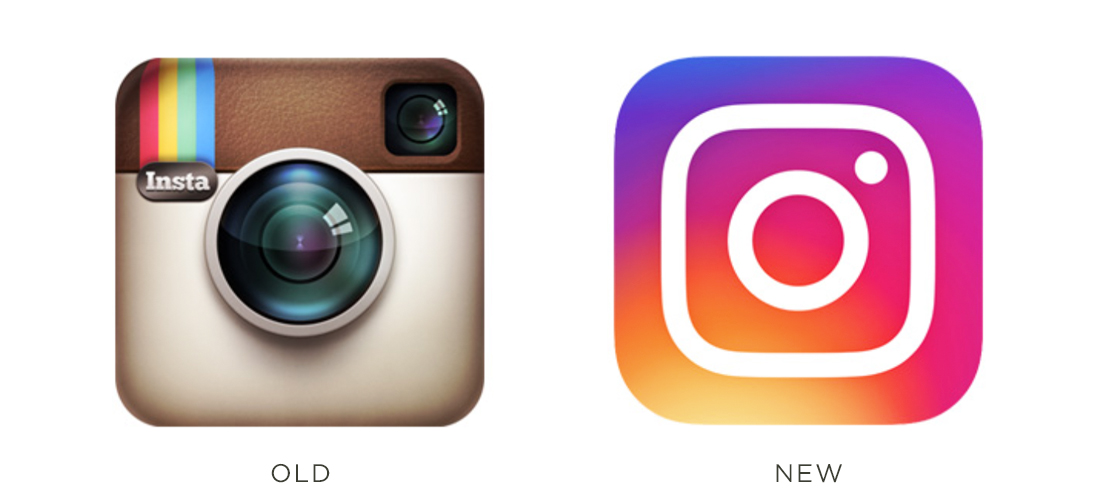
When Apple first launched iPhone, much of its interface followed skeuomorphic design principles. Skeuomorphic design pulls ornamental elements from real-life objects and brings them into the digital realm even though those elements are no longer necessary. For example, the top of Apple’s iCal App interface used to look like leather with stitching; the Notes App used to look like a real notepad with paper torn at the top; Apple’s Newsstand used to look like a miniature wooden book shelf…you get the idea.
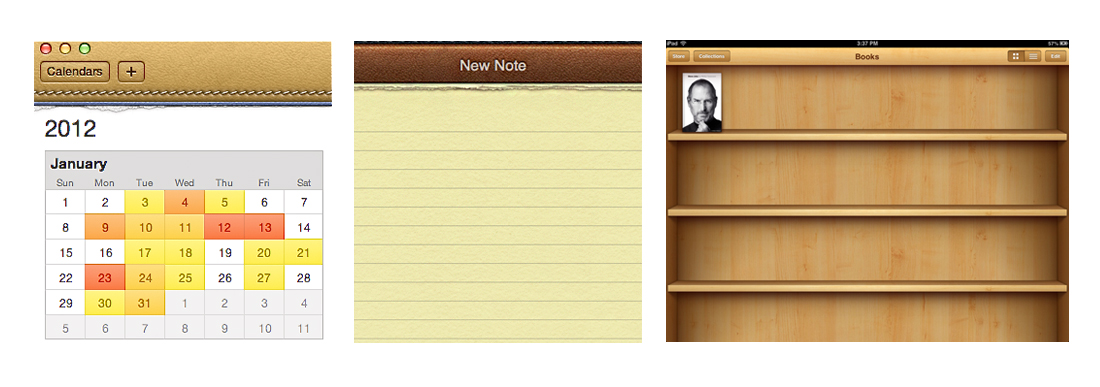
The old Instagram logo was still stuck in this dated, literal representation of an object realm.
The new logo strips away all the unnecessary decorative elements and gives us the bare minimum of visual cues necessary for our brains to decipher that the logo is a representation of a camera. In my opinion, when it comes to app design, for the most part, cleaner and simpler equals better ease of usability.
Color doesn’t always equal tacky, and black doesn’t always equal elegant.
As for that rainbow gradient of colors in the background of the logo? The part of me that jumps for joy when seeing a rainbow—or even better, a double rainbow—loves it. I’ve never been one to shy away from color in anything in my life; from my wardrobe to design to my apartment decor.
Color doesn’t always equal tacky, and black doesn’t always equal elegant. Color, when used appropriately, can elevate a design to a whole new level, so don’t be afraid of it!
But another part of me worries that these colorful gradients are just a fleeting trend and five to 10 years from now, we’ll all be saying, “Oh, yeah, that was definitely made in 2016.”
Usually, good design doesn’t rely on short-lived trends. Logos like Coca-Cola, GE and IBM have stood the test of time because each were designed using unwavering core design principles and with longevity in mind. But then again, Instagram exists in a fleeting, temporary digital realm, so maybe they’re allowed to design something that won’t make it to the year 2116.
Overall, I’d say it’s an upgrade and a step in the right direction, but this new logo might be so simplified and trend-based that Instagram has given its new brand a very short shelf life.
On the making of Southwest Airline’s latest work, “High School Reunion” – this was a fun spot to make. Everyone who goes to their high school reunion enters with some baggage. It’s inevitable. You’re now a confident, successful adult, but you walk into that room and a small part of you is transported back to high school and everything that goes along with it. We liked everyone turning to look at our hero, and for a brief moment, you see her revert to her sixteen-year-old-self, wondering if she has pizza on her dress or something stuck in her braces. Then we see her confidence build and she owns the room.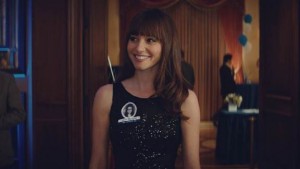 We also had fun mixing a bunch of our favorite things together: beautifully composed shots by director Jun Diaz. En Vogue. And a cast with a John Hughes vibe, complete with ex quarterback turned car dealership salesman. I can smell the CK One from here.
We also had fun mixing a bunch of our favorite things together: beautifully composed shots by director Jun Diaz. En Vogue. And a cast with a John Hughes vibe, complete with ex quarterback turned car dealership salesman. I can smell the CK One from here.
Allow us to take you back to your high school days here.
By Kelsey Karst, Studio Art and Design Intern
As the Cannes Lions Festival kicks off this week, marketers and agencies across the globe are anxiously awaiting to discover who will take home the 2015 awards across the Health, Lions and Innovation tracks. “The Cannes Lions will recognize and award the year’s most exciting creative ideas across 20 categories, covering everything from traditional print and film communications to technology and product design,” according to canneslions.com. Ideas and brands will be recognized and celebrated, in addition to introducing new creative ideas for the upcoming year.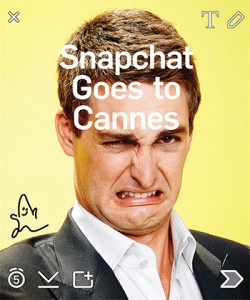 This year, the spotlight is on Evan Spiegel, CEO of Snapchat. Today at Cannes, Spiegel introduced what could become the most efficient, influential and useful media platform. Spiegel took the main stage to discuss his plan to open his company up to marketers, which is predicted by many to take the advertising world by storm. Discover partner and Cosmopolitan Editor in Chief Joanna Coles interviewed Spiegel onstage earlier this afternoon about creativity, millennials and what he thinks will excite this generation next.
This year, the spotlight is on Evan Spiegel, CEO of Snapchat. Today at Cannes, Spiegel introduced what could become the most efficient, influential and useful media platform. Spiegel took the main stage to discuss his plan to open his company up to marketers, which is predicted by many to take the advertising world by storm. Discover partner and Cosmopolitan Editor in Chief Joanna Coles interviewed Spiegel onstage earlier this afternoon about creativity, millennials and what he thinks will excite this generation next.
Spiegel went into detail on the creation of Snapchat: four years ago in a college dorm room at Stanford with a few of his fraternity brothers. He goes on to discuss how “Snapchat is trying to incorporate relevant advertising without being creepily targeted in the messaging.” He touches on the importance of retaining the anonymity and privacy of users while still providing the tools advertisers need to be effective. Spiegel discussed that brands now have the ability to sponsor videos, location-based filters that viewers use when they are within a certain geographic area. He also highlighted the newest advertiser taking part, which is Procter and Gamble, who sponsored Snapchat’s Father’s Day story live-stream. A lot of today’s crowd was just getting introduced to Snapchat, but this talk left both Spiegel and the audience confident in the progression of this app and what it will do for the advertising world, according to Garett Sloane of Adweek.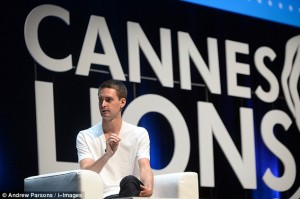 What is especially worth noting is that, even just a couple of years ago, Snapchat would never have been deemed credible enough to be featured at Cannes. The brand’s evolution is extraordinary. What started as a peer-to-peer-image-sending app soon grew to incorporate video, location and visual graphics. Snapchat then went on to tackle texting by adding a messaging platform. Most recently, Snapchat added the “discover” button to keep its users up to date on news and current events through select media partners like Comedy Central, ESPN, Daily Mail, Cosmopolitan and VICE. In just four short years, Snapchat essentially has it all. It has the ability to take market share away from WhatsApp, Facebook, Instagram and even Twitter—which is what makes it so appealing to advertisers. It is not a once-a-day use application, it is a 20-per-day use application; this user frequency is advertising gold.
What is especially worth noting is that, even just a couple of years ago, Snapchat would never have been deemed credible enough to be featured at Cannes. The brand’s evolution is extraordinary. What started as a peer-to-peer-image-sending app soon grew to incorporate video, location and visual graphics. Snapchat then went on to tackle texting by adding a messaging platform. Most recently, Snapchat added the “discover” button to keep its users up to date on news and current events through select media partners like Comedy Central, ESPN, Daily Mail, Cosmopolitan and VICE. In just four short years, Snapchat essentially has it all. It has the ability to take market share away from WhatsApp, Facebook, Instagram and even Twitter—which is what makes it so appealing to advertisers. It is not a once-a-day use application, it is a 20-per-day use application; this user frequency is advertising gold.
Brands can replicate this style of user behavior to better engage with the Snapchat community. Brands could essentially take more risks in their advertisements if they appeared on Snapchat. They could create humorous ads that could be viewed for that allotted time, and it would disappear. I also think the quick viewing of an advertisement would make it more appealing to users because it’s an interactive video that would only take 10 seconds to watch, rather than interrupting you for 30 seconds to a minute, like YouTube video ads. Because of poor planning, some advertisements come up at an inconvenient time and are too lengthy, causing viewers to be agitated rather than intrigued. If marketers played around with this idea by making the message visually appealing, humorous and/or playful for this younger audience, I think this could be a very successful outlet. Whether it’s a quick snap of a delicious Chipotle meal, or a five-second video of someone trying to shove a burrito down in one bite, it enables viewers to keep the brand top of mind.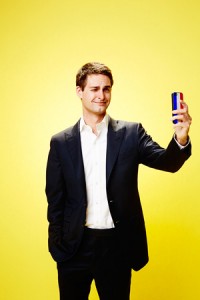 Recently, Snapchat showed its powerful impact during ABC’s broadcast of the American Music Awards. Three million viewers tuned in, while Snapchat Live Story broadcasted snippets of the event and drew in 11.5 million viewers, according to the Adweek article, “How Snapchat’s CEO Plans to Conquer the Advertising World. His first time at Cannes, Evan Spiegel is already star of the show.” As Snapchat continues to increase its user base and expand content options, advertising is starting to become part of this platform, as introduced today by Spiegel himself. Both Spiegel and Cannes Festival attendees seem excited to see what direction Snapchat could steer advertising and ideas, if anywhere at all.
Recently, Snapchat showed its powerful impact during ABC’s broadcast of the American Music Awards. Three million viewers tuned in, while Snapchat Live Story broadcasted snippets of the event and drew in 11.5 million viewers, according to the Adweek article, “How Snapchat’s CEO Plans to Conquer the Advertising World. His first time at Cannes, Evan Spiegel is already star of the show.” As Snapchat continues to increase its user base and expand content options, advertising is starting to become part of this platform, as introduced today by Spiegel himself. Both Spiegel and Cannes Festival attendees seem excited to see what direction Snapchat could steer advertising and ideas, if anywhere at all.
The author of the Digiday article RIP Creative Director: Creativity Belongs to Everyone makes many valid points. Can good ideas come from anywhere? Of course. Do agencies need to shift how they think about the creative process? Absolutely. Is the creative director dead? No. And I don’t plan on going anywhere. (Unless I sell my screenplay.)
I know what you’re thinking: Of course the creative director begs to differ. And I also know by doing so, I’m feeding into the often-painted picture of “traditional” creative directors as dated thinkers, desperately clinging to our dominion over the creative process. Well, let me play into that characterization even more: There are such things as bad ideas.
There. I said it. Now you definitely have a picture of who I am, don’t you? A smug creative director in trendy glasses. Yup, that’s me. Only I’m a chick, so adjust that in your head. There. Now you have me pegged.
Not All Ideas Are Good
This is unpleasant, but true. There are bad ideas, good ideas, ideas that are better than others and ideas that aren’t good yet but have the potential to be good. And unfortunately, it’s hard to tell the difference. You need someone steering the ship to do that. Without a creative director to step in, we’d all be flailing in half-baked ideas, which is a terrible place to flail.

Bigger Isn’t Always Better
Have you ever been in a huge brainstorm where people get really excited and write down half phrases and draw half pictures on whiteboards, and everyone feels like we’re striking gold left and right? Have you ever then been able to recall one idea that came out of a brainstorm like that? Me neither. The creative department shouldn’t have a monopoly on the creative process, but small groups work better when it’s time to actually create.
Creativity Isn’t a Defined Process
I’m interested in Applied Creativity. I’m sure there are useful techniques involved that prevent the whiteboard debacle I just described from happening. But then again, “a formalized idea-management process” is only going to take us so far.
Gathering data and behaviors to innovate new technologies and create prototypes is great, but we’re always going to need ideas, not just executions. Stories. I know, I know. Here I go again, the dated creative director making a plea for broadcast. I’m not talking about broadcast. I’m talking about stories. Ideas that aren’t quantifiable but make people feel because they tap into something human. It’s difficult to come up with a story with 10 people involved. Two works better, maybe three. Or one. And it helps if that one knows how to write.
There’s No Single Answer
Things are changing. But there’s also no one answer for how to address it. Do we have it completely figured out at GSD&M? No. But it’s a place that embraces collaboration, not through any defined process, but through culture. All of the work is pinned to the agency walls: everyone can see it, add to it and ask questions. Jay Russell, our CCO, is constantly buzzing around the agency, pointing to things on those walls, getting people excited about the possibilities, challenging us to make it all better. I don’t know everyone’s titles here. But I know if I want a different perspective on social or mobile, I should buy Rye Clifton a beer. David Rockwood and Bill Bayne know music. Jeffrey Butterworth can write and draw. For an uncensored gut check on whether I’m even making sense, I talk to Kate Rutkowski, who is on the account side. Crazy, I know.
Maybe we should start calling creative directors something else to open up the definition more, to change the perception that it has to be a certain someone with a certain background in art direction or copywriting. Or we could spend the time and energy we’d use coming up with a new name for creative directors on creating new ideas that make a difference. That seems like a better idea to me. And you know, that is my job, to pick out the better ideas. I earned my paycheck today, Jay.
(GSD&M’s creative department)
